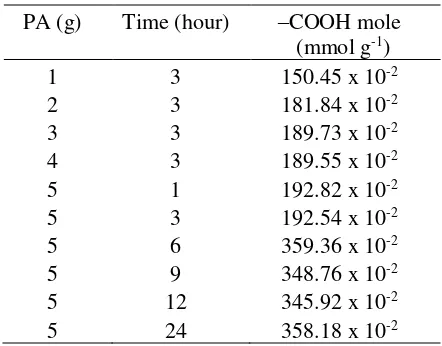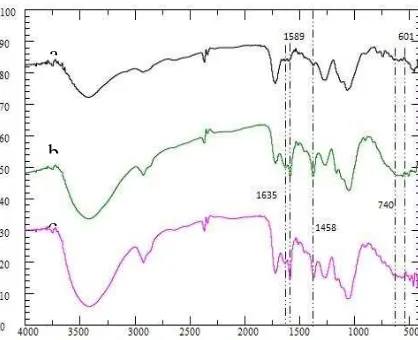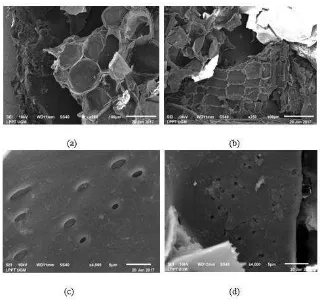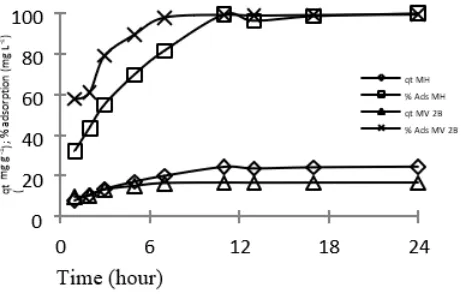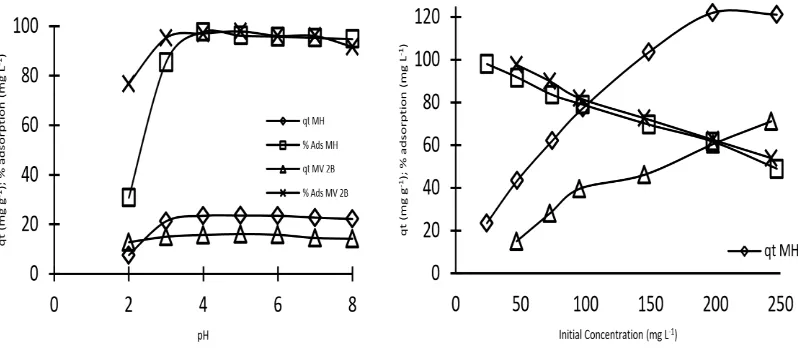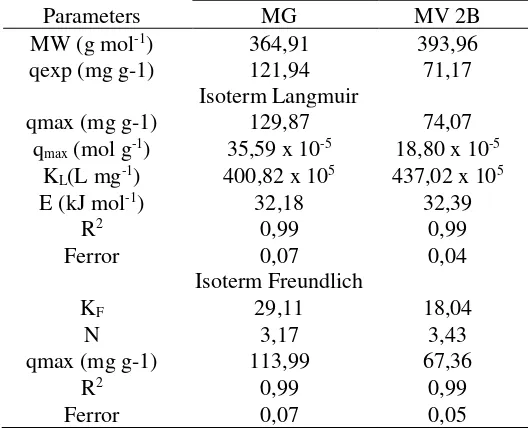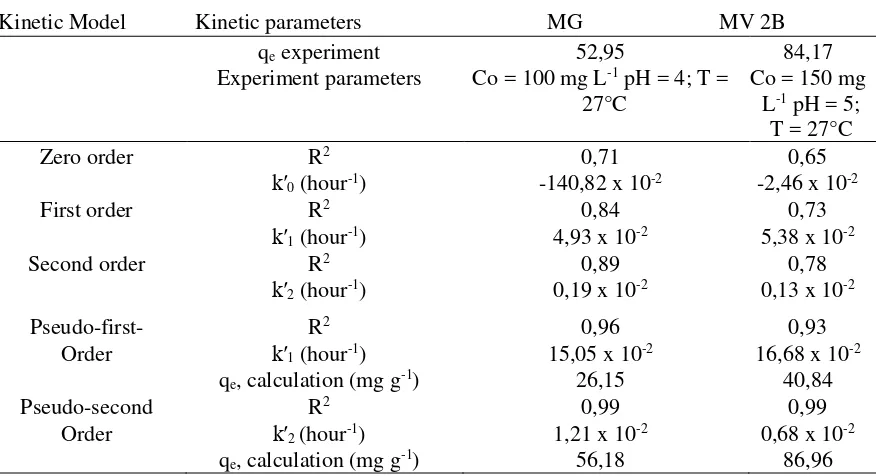Adsorption of Malachite Green and Methyl Violet 2B
with Phthalate-Functionalized Sugarcane Bagasse
Adsorpsi Hijau Malachite dan Violet Metil 2B
dengan Ampas Tebu Terfungsionalisasi Ptalat
Dwi Ariani, Nurul Hidayat Aprilita, Agus Kuncaka
Departement of Chemistry, Faculty of Mathematics and Natural Science, Universitas Gadjah Mada Sekip Utara PO BOX BLS 21 Yogyakarta 55281, Indonesia *Corresponding author. Tel: +62-85643480050 Email address: dhuariani@gmail.com
Abstract
In this study, the adsorption of malachite green and methyl violet 2B by phthalate-functionalized sugarcane bagasse (SPA) was investigated. The chemical modification of sugarcane bagasse (SB) with PA using pyridine as a solvent and the SPA was optimized through the evaluation of the effects of mass ratio of SB-PA and reaction time of reflux on the value of carboxylic acid groups amount on SPA surface. The amount of carboxylic acid groups amount on SPA surface was determined by back titration. SPA was characterized by Fourier transform infrared (FTIR), and scanning electron microscope (SEM) was used to adsorption of malachite green (MG) and methyl violet (MV) 2B. The back titration result showed that mass ratio of SB-PA 0.5:5 and reaction time 6 hours as the optimum conditions with the number of carboxylic groups of 359.36 x 10-2 mmol g-1. The FTIR result showed that SPA has a characteristic peak of carboxylic groups and SPA has the bigger pore size than SB showed by SEM. The optimum adsorption condition of MG with the value 121.94 mg g-1 was achieved at 20 mg SPA, pH 4 for 11 hours. The optimum adsorption condition of MV 2B with the value 71.17 mg g-1 was achieved at 30 mg SPA, pH 5 for 7 hours. The adsorption kinetics followed a pseudo-second-order with the rate constants for MG and MV 2B 1.21 x 10-2 and 0.68 x 10-2 hour-1, respectively. The adsorption behavior fit quite well with Freundlich model with adsorptions energy for MG and MV 2B 32.18 and 32.39 kJ mol-1, respectively.
Keywords: Sugarcane bagasse, Phthalate anhydride, Adsorption, Malachite green, Methyl violet 2B
Abstrak
L-1 diperoleh kapasitas adsorpsi sebesar 71,17 mg g-1. Kinetika adsorpsi ATMF terhadap zat warna MH dan MV 2B mengikuti kinetika orde dua semu dengan konstanta laju MH dan MV 2B berturut-turut sebesar 1,21 x 10-2 dan 0,68 x 10-2 jam-1. Tipe isoterm adsorpsi ATMF yaitu tipe isoterm Freundlich dengan energi adsorpsi MH dan MV 2B berturut-turut sebesar 32,18 dan 32,39 kJ mol-1..
Kata kunci: ampas tebu, ftalat anhidrat, adsorpsi, malasit hijau, metil violet 2B
1.
Introduction
Synthetic dyes were the prominent ingredients required in various industries such as textile, paper, wool and cosmetics industries (Robinson, 2001). The disposal of wastewater into the environment was a problem because it has chemical, photochemical and biological high resistance (Reis, 2011). The dyestuff waste has high solubility, cannot be degraded in nature and contains a variety of compositions in water. Industrial dyestuff liquid waste can cause various health problems, such as allergies, skin irritation, cancer, and mutations in humans (Jalil, 2011). The dye may be classified by chemical structure or method of application (Bonetto, 2015). Dye stuff was often used as basic dyes in the textile industry, namely dye triphenylmethane such as malachite green (MG) and methyl violet 2B (MV) (Kristianto, 2016)
Triphenylmethane dye that was xenobiotic compound widely used in various industrial processes, including textile, printing, paper making, leather tanning, food, and cosmetics industries (Chen, 2010) According to Chen et al. (2010) malachite green and methyl violet 2B (100 mg L-1) WERE toxic after testing of mouse cells. Malachite green will be reduced to a leukomalachite green that is persistent in the body and is carcinogenic (Culp, 2006). Exposure to methyl violet 2B repeatedly in the long term will cause damage to the organ (skin and eyes) (Hameed, 2008). Various methods of processing dye waste have been widely developed, among others, the method of biodegradation (Chen, 2010). Photocatalytic degradation (Wu, 2017); Catalytic degradation (Fayazi, 2016); and adsorption.
Adsorption is a method that has high efficiency, easy, and cheap so widely used for processing toxic dye waste (Zhu, 2015). The adsorption method with biosorbent is widely used because it is cheap and effective [4]. Sugarcane bagasse is a sugar industry waste that needs further utilization to have a higher use value and not pollute the environment. Chemically, the main constituent component of the bagasse is the fiber in which the cellulose group is contained, polyesters such as hemicellulose, lignocellulose, and lignin (Santosa, 2003). Cellulose is a polymer matrix that is very likely to be synthesized into new adsorbents with various benefits (Zhu, 2015). The utilization of lignocellulose sulfonate bagasse for adsorption of basic textile cationic textile 10 shows the adsorption power of 87.42 % (Suryadi, 2016).
The study was developed by modifying the functional groups on bagasse as an adsorbent. Modification of sugarcane bagasse functional groups aims to increase the adsorption capacity so that the amount of adsorbed ions is maximal. The modification is done by converting the surface activated a group of bagasse -OH into a more -COOH group. Research on modification of bagasse with anhydrous phthalate for adsorption of Co, Cu, and Ni metals showed adsorption results from high to low, respectively Cu, Ni, and Co (Ramos, 2016).
2.
Experimental Section
2.1
Materials
Sugarcane bagasse obtained from Madukismo Sugar Factory. Analytical grade anhydrous phthalate 99%, isopropanol, anhydrous calcium chloride, NaOH, HCl, acetone, pyridine, green malachite (MH), methyl violet 2B (MV), deionized distilled water were purchased from Merck (Germany).
2.2
Instrumentation
Equipment used is laboratory glassware, separating funnel, oven, analytical balance (Mattler Toledo AB54-S), pH meter (TOA model HM 30R), centrifuge, magnetic stirrer, shaker (Marius), the concentrations of malachite green (MG) and /methyl violet (MV) 2B in the adsorption experiment were analyzed using UV-Vis Spectrophotometer (Thermoscientific 20D). Characterization of SPA before and after adsorption was performed using Fourier Transform Infra-Red Spectrophotometer (Prestige-21, Shimadzu) for the functional group identification. The morphology of samples was viewed by Scanning Electron Microscope (Jeol JSM6510LA) instrument.
2.3
Procedure
Preparation and activation of sugarcane bagasse
The sugarcane bagasse was provided by Madukismo sugar mill was dried under the sunlight for 1 week. The dried sugarcane bagasse then sieved to 16 mesh. Activation of adsorbent was done by Ramos et al. (Ramos, 2016). with sugarcane bagasse (100 g) were attached to 2 L beaker containing distilled water. It was magnetically stirred at 70 °C for one hour then washed with distilled water and acetone and dried in an oven at 90 °C. The sugarcane bagasse was washed with Soxhlet apparatus with ethanol/hexane (1:1, v/v) solvent for 4 hours and dried in an oven at 90 °C. The activated sample was stored in the desiccator before use.
Modification of sugarcane bagasse with
anhydrous phthalate
Modification sugarcane bagasse with anhydrous phthalate was conducted based on Ramos et al. (2016). Sugarcane bagasse (0.5 g), anhydrous phthalate (1,2,3,4 and 5 g), and anhydrous pyridine was added in a 100 mL flask with a ratio of 1:15 (w/v), with added calcium chloride Anhydrous in the condenser drying tube. The mixture was heated at 100 °C while stirring mechanically with a magnetic stirrer at 300 rpm for 1, 3, 6, 9, 12, 18 and 24 hours. The mixture was allowed to cool for 30 minutes and transferred to a beaker glass containing 75 mL of isopropanol while stirring for 30 minutes. The mixture was washed with isopropanol twice. The mixture was then filtered and washed with 50 mL distilled water, 0.01 mol L-1 50 mL HCl solution, 50 mL distilled water, and 25 mL of isopropanol. The washing results were dried in a 95 °C oven for 2.5 hours and placed in a desiccator. The amount of carboxylate group formed was used to determine the optimum ratio of the anhydrous phthalate mass and the reflux time.
Characterization of modified sugarcane bagasse with
anhydrous phthalate
The amount of carboxylate group formed was determined by back titration. Two samples of 0.1 g of SBPA were attached in Erlemeyer 250 mL and 100 ml of NaOH standard added to each Erlenmeyer. The Erlenmeyer was stirred for 60 minutes at 25 °C. The mixture was filtered and three sample solutions of 20 ml each were titrated with 0.1 M HCl. The amount of carboxylate group formed was calculated by the formula:
NaOH volume, VHCl (L) is the volume of HCl solution used for titration the extended that unconsummed by NaOH, and WSBPA (g) is the weight of the SBPA.
The functional groups in SBPA were identification by FTIR. The samples were dried in an oven at 90°C for 1 hour then mixed with KBr powder. Measurements were made in the range of 500-4000 cm-1 waves. The surface conditions of SBPA was a measurement of SEM. The sample was dried in an oven at 90 °C for 1 hour then as much as 50 mg of SBPA was diluted on the surface of the two-faced adhesive vacuumed and coated with a thin gold coating in a thin coating machine (sputter) which was then placed on the sample holder. Samples were observed at a voltage of 20 keV and a secondary electron detector (SE).
Adsorption studies
Effect of adsorbent mass
SBPA (5, 10, 15, 20, 25) mg was added into 20 mL malachite green solution with concentration of 25 mg L-1 and SBPA (5, 10, 15, 20, 25, 30, 35) mg was added into 20 mL with concentration of 25 mg L-1 methyl violet 2B solution, further shaker at 180 rpm for 180 min. The mixture was centrifuged to obtain a solution without pulp. The concentration of the dye was determined using a UV-Vis Spectrophotometer.
Effect of reaction time
The optimum mass SBPA obtained from the previous procedure was added to 20 ml of malachite green and methyl violet 2B solution with concentrations of 25 mg L-1 each. The mixture was shaker at 180 rpm for 1, 2, 3, 5, 7, 11, 17, and 24 hour intervals. The mixture was centrifuged to obtain a solution without pulp. The concentration of the dye was determined using a UV-Vis Spectrophotometer. Variations in contact time were also performed after SBPA mass condition; pH and optimum adsorbate concentration were obtained to determine the adsorption kinetics.
Effect of pH solution
The optimum mass SBPA obtained from the previous procedure was added into 20 ml of malachite green and methyl violet 2B solution with a concentration of 25 mg L-1 each with a pH adjusted between 2, 3, 4, 5, 6, 7, and 8. The mixture was shaker out of 180 rpm stirring rate with optimum time obtained from previous procedure then centrifuged to obtain a solution without pulp. The concentration of the dye was determined using a UV-Vis Spectrophotometer.
Effect of initial dye concentrations
The optimum mass SBPA obtained from the prevoius procedure was added into 20 ml of malachite green and 2B methyl violet solution with variations of concentration 25, 50, 75, 100, 150, 200, and 250 mg L-1 at optimum pH conditions obtained from the prevoius procedure. The mixture then shaker out with a 180 rpm stirring rate with optimum time obtained from the previous procedure then centrifuged to obtain the solution without pulp. The concentration of the dye was determined using a UV-Vis Spectrophotometer. Data on the initial dye concentration variations were used to determine the SBPA adsorption isotherm with malachite green and methyl violet 2B.
3.
Result And Discussion
The modification of sugarcane function groups by anhydrous phthalates as an adsorbent of malachite green (MG) and methyl violet (MV) 2B was investigated. The SB modification method was following the methodology proposed by Ramos et al. (Ramos, 2016). The sugarcane bagasse was refluxed with anhydrous phthalate as a modifying agent in a pyridine solvent (Sun, 2010). Anhydrous phthalate was a
Characterization the amount of carboxylate group formed with back titration
The SBPA adsorbent synthesis reaction in Figure II.1 shows the result of the reaction obtained was a carboxylate group in sugarcane bagasse. The optimum results of carboxylate groups in bagasse are presented in Table (1).
The result of optimizing mass ratio SB: PA and reaction time are presented in Table 1 which shows that the greater mass of the anhydrous phthalate used, the greater number of carboxylic moles produced. As more modifiers were used, the likelihood of a larger reaction as more and more active sites was present. The result data of the time variation shows the number of moles of carboxylate more up to the optimum time. At the time of reflux 9 and 12 hours, the number of moles of carboxylate decreases because of possible reactions to decompose the product formed. At 24 hours reflux, there is an increase in the number of moles of carboxylates. However, the increase of the carboxylic mole obtained was not proportional to the energy used for the reflux process. Therefore, the 6-hour reflux time is chosen as the optimum reflux time of the SBPA with the mass ratio SB: PA = 0.5: 5. In this condition, the mole's value of carboxylates produced has the highest value in efficient energy.
Characterization SBPA with FTIR
FTIR analysis is performed on SB and SBPA. The results of FTIR analysis were presented in Figure 1. The focus attention was the appearance of peaks in the number of waves: (1) 3025 cm-1 illustrating the intermolecular bond of a hydrogen atom in a carboxylate and oxygen group in a carbonyl ester group; (2) Peaks in 2646 and 2580 cm-1 were related to the stretching of hydrogen aromatic carboxylic acid-dimer bonds; (3) a strong peak at 1703 cm-1 indicated the stretching of the carbonyl ester conjugate; (4) Peaks in 1597 and 1504 cm-1 showed stretching of C = C in benzene rings; (5) The peak of 1264 cm-1 was a C-O stretching in esters and carboxylates; (6) Peaks at 740 cm-1 showed an unusual C-H bond due to substitution of the benzene ring (Pavia, 2014). The appearance of the peak in 1800-1850 cm-1 showed the presence of symmetrical and asymmetric stretching of the cyclic anhydrous carboxylic group, known that the SBPA no longer interacts with the residual FA [18:17]. The results of spectral SB and SBPA ratios showed the appearance of characteristic peaks with the top of the carboxylate group.
Table 1 Optimizing SB modifications
PA (g) Time (hour) –COOH mole (mmol g-1)
1 3 150.45 x 10-2
2 3 181.84 x 10-2
3 3 189.73 x 10-2
4 3 189.55 x 10-2
5 1 192.82 x 10-2
5 3 192.54 x 10-2
5 6 359.36 x 10-2
5 9 348.76 x 10-2
5 12 345.92 x 10-2
5 24 358.18 x 10-2
indicating an overlap of the peak of 1504 cm-1. Increased intensity at 601-740 cm-1 indicated an increase in substitution of benzene rings.
Figure 1 FTIR spectra of a) SBPA and b) SB
Figure 2 FITR spectra of a) SBPA; b) SBPA loaded MG; and c) SBPA loaded MV 2B
Characterization SBPA with SEM
SB and SBPA samples were analyzed by SEM to determine their surface morphology. The SEM results showed that the SBPA has a more hollows surface with a larger pore than SB. The size of the bag was 84.41 m, and the pore size was 1.05-4.75 m. This was by Musyoka et al. [19] where the modification of the functional group carried out makes the fiber undergoing the arrangement and change of surface texture. Bag size and larger pore size allow SBPA to adsorb MH and MV 2B dyes better than SB.
The application of the SBPA adsorbent that has been made and characterized was done by the study of adsorption on the cationic dye of MG and MV 2B. The adsorption study was performed with several parameters such as SBPA adsorbent mass, contact time, pH of MH and MV 2B dye solution, adsorption isotherm and adsorption kinetics.
Measurements of adsorption of cationic dyes of MG and MV 2B were performed using a visible spectrophotometer so that a preliminary study of the maximum wavelength measurements of MH and MV 2B cationic dyes with concentrations of 3 mg L-1 with pH of double distilled water was measured. Maximum wavelength measurement results for MG and MV 2B were 617 and 585 nm
a
b
respectively. The results of this study did not very much different with the research of [20] which obtained the maximum wavelength of MH at 615 nm. The result of measurement of MV wavelength 2B was not much different from the research before at 585 nm.
Effect of SBPA mass
The adsorption process was influenced by the factors of adsorbent and absorbat interacting. The adsorption study in this study was started from the SBPA adsorbent factor used. The adsorbent mass used affects the amount of MH and the adsorbed MV 2B. The adsorption process was carried out at 20 mL of MG and MV 2B solution at 25 mg L-1 concentration. The effect of the mass of SBPA adsorbent on adsorption capacity and percent of adsorption was presented in Figure 3.
Figure 3 Effect of SBPA mass
Based on the data on the variation of the adsorbent mass of SBPA used, it was known that the more adsorbent mass of SBPA used, the adsorption capacity and the percent of adsorption of MG and MV 2B dyes were greater. The number of active sites of adsorbent was increasing, so the possibility of interaction with dye adsorbat was greater and the amount of dye more and more adsorbed. The same results were obtained by Musyoka et al. [19] methyl violet adsorption with modified cellulose found that the adsorbent mass was proportional to the percent of methyl violet 2B adsorption.
Adsorption MG and MV 2V
SBPA masses, MG decreases faster the adsorption capacity and percent of adsorption. According to Chiou and Chuang the speed of adsorption reaches the equilibrium point influenced by molecular weight. Smaller molecular weights spread faster to the surface of the adsorbent so that it reaches the equilibrium point faster (Chiou and Chuang, 2016).
Effect oF reaction time
The contact time affects the adsorption process. The longer the contacting time of the SBPA adsorbent with the cationic dye of MG and MV 2B, the adsorption capacity and percent of adsorption will increase. The increase in adsorption capacity and percent of adsorption reached the optimum value when the adsorbent was in effective condition for adsorbing MG and MV 2B.
Based on Figure 4 it was known that the optimum contact time for adsorption of MG and MV 2B cationic dye respectively was 11 and 7 hours. The time obtained was long enough due to the adsorption of MG and MV 2B through several stages. MG and MV 2B face the limits of the adsorbent layer, then adsorbed on the surface and eventually diffuse into the adsorbent pores (Kuppusamy, 2017). At longer contact times, the adsorption capacity and percent adsorption tend to be constant as the active site of the SBPA adsorbent approaches the saturation point making it difficult to adsorb the cationic dyes of MG and MV 2B. Adsorption process of MH cationic dye having a smaller molecular weight takes a long time to reach the optimum because the number of active sites of SBPA adsorbent was less than in MV 2B. The probability of interaction between the active site of the SBPA adsorbent and the MG was less than that of the SBPA adsorbent interaction with MV 2B. However, MH adsorption percent was 99.99 % higher than that of MV 2B of 99.05 % because of its smaller molecular weight so it can be adsorbed on smaller pores (Luo et al., 2017). The study by Bharali et al. (Bharali and Deka, 2017) obtained a percentage percent of methyl blue adsorption (smaller molecular weight) greater than rhodamine (greater molecular weight) with CuMgAl4 LDH adsorbent.
Figure 4 Effect of reaction time
Effect of pH solution
The environment condition greatly affects the occurrence of the adsorption process. In this research, the adsorbat effect of the cationic dye of MG and MV 2B on the adsorption process with SBPA adsorbent was studied by pH variation. The range of pH variation was made from pH 2-8. The result of pH variation on the adsorption of the cationic dye of MG and MV 2B was presented in Figure 5.
5 with an adsorption capacity value of 16.07 mg g-1 and an adsorption percentage of 97.86 %. The results showed that the conditions were too acidic, the adsorption capacity and the adsorption percent tended to be low because of the competition of dye cations with acidic cations (Sewu et al., 2016). Under too alkaline conditions, the dyestuff cations react with an alkaline anion resulting in a precipitate. In this study, the maximum pH range at pH value eight because at a higher pH appears sediment.
Despite the non-extreme base conditions, the adsorption capacity and percent of adsorption decreased. This was because of the SBPA adsorbent was an adsorbent with acidic properties which can react with an alkaline anion so that the number of active sites of SBPA adsorbent decreases in the base environment.
The results of this study by research Musyoka et al. [19] methyl violet adsorption with a modified cellulose adsorbent wherein at a very acidic pH the adsorption capacity has low, and at slightly basic pH the adsorption capacity did not increase.
Adsorption Isotherm
The adsorption isotherm study was done by studying the effect of the initial concentration of the cationic dye of MG and MV 2B. The SBPA adsorbent was used to adsorb the cationic dyes of MG and MV 2B in various concentrations.
The adsorption results of MG and MV 2B at various concentrations showed that the initial concentration was directly proportional to the adsorption capacity. The SBPA adsorbent capacity of MG and MV 2B were increased with the greaterin the initial concentration of MG and MV 2B. The relationship between the initial concentration and the adsorption percent made to determine the optimum initial concentration.
The relationship between the initial concentration and the adsorption percent shows the inversely proportional. The optimum initial concentration was determined by looking at the most balanced value between adsorption capacity and % adsorption or the smallest difference value with the assumption that conditions of the SBPA adsorbent and the MG or MV 2B adsorbates were equally considered. It became important because in the adsorption process both adsorbent and adsorbates interacted. The optimum initial concentrations of MG and MV 2B were 100 and 150 mg L-1, respectively.
MV 2B has a higher optimum initial concentration due to the higher number of active adsorbent sites so that it can adsorb more dye molecules than the active adsorbent site for MG. However, the adsorption capacity and MG adsorption percentage were 77.29 mg g-1 and 78.926% respectively higher than that of MV 2B with 60.48 mg g-1 and 62.46% respectively. This is due to the smaller molecular weight of MG allowing it to be adsorbed on small pores.
The result of concentration variation was used to know the type of adsorption isotherm that occurs between the adsorbent of SBPA with the adsorbate of the cationic dye of MG and MV 2B. The isotherms type describes the interaction between the SBPA adsorbent and the MG or MV 2B cationic dye. The isotherms model used in this study was Langmuir and Freundlich isotherms. The results of the isotherm model calculations were presented in Table 2.
The Langmuir isotherm assumes that the adsorption of MG and MV 2B monolayers on homogeneous SBPA adsorbents. Based on Table 2 the qmax value MG of the Langmuir isotherm equation in greater than qmax MV 2B which means the SBPA adsorbent ability in adsorbing MG was better than its ability to adsorb MV 2B. However, the qmax ATMF study was higher than that of other adsorbents. Rajabi et al. developed a modified carbon nanotube adsorbent in the presence of a cyoxylate group obtained by qmax of 11.95 mg g-1 (Rajabi, et al., 2016). Bonetto et al. [4] made a magnetite composite adsorbent to adsorb MV 2B obtained qmax results of 20.04 mg g-1. The ATMF adsorption capacity is greater than AT which has qmax MH and MV 2B respectively 67,42 and 37,38 mg g-1. Langmuir isotherm equation determined the amount of adsorption energy MG and MV 2B.
Table 2 Isotherm parameters for adsorption of MG and MV 2B using SBPA adsorbent
Parameters MG MV 2B
Freundlich isotherms assume that the adsorption process takes place on heterogeneous surfaces where interactions between MG or MV 2B adsorbate molecules and adsorption are not limited to monolayer formation [4]. Freundlich constant (KF) corresponded to the adsorption capacity of the SBPA adsorbent wherein the higher the KF price, the higher the adsorbent affinity of MG and MV 2B. Based on Table 2 it was known that KF MG was greater than KF MV 2B so that the interaction between adsorbate MG was stronger than MV 2B. The empirical parameter (n) was an adsorption intensity if the value of more than 1 indicates the adsorbate MG and MV 2B were easily adsorbed on the SBPA adsorbent (Zhu, 2015).
The experimental fact that the ATMF adsorbent has a heterogeneous surface showed that a more suitable isotherm model was the Freundlich, isoterm model. This was also supported by the value of MH and MV 2B adsorption energy of less than 40 kJ mol-1. Gasser (1987) suggests that physical adsorption requires about 5-40 kJ mol-1 energy. Physical adsorption occurred multilayer, and there were interactions between adsorbat. The interaction between ATMF adsorbent and MH and MV 2B was the dipole-dipole interaction. The ATMF adsorbent that has an active site -COOH allowed for the delocalization of electrons and dipole formation. While MH and MV 2B adsorbate was a cationic dye that has a permanent dipole. The interaction between the two produces the Van der Waals force that was the surface tension between the surface of the solution, and the surface of the adsorbent was greater than the tensile strength of MH and MV 2B with the solution. Therefore, MH and MV 2B can be adsorbed on the surface of the ATMF. The interaction between the adsorbate both MH and MV 2B also occurred because of the dipole affected by the electron cloud in the ATMF and formed multilayer adsorption.
Kinetics Adsorption
The kinetics study was performed by adsorption of MG and MV 2B performed by time variation in SBPA mass condition, pH, and optimum concentration. This research uses several kinetic equations to find out the adsorption rate and kinetic model. The kinetic equations used in this research are kinetics of zero order, first order, second order, pseudo-order one, and pseudo-second order. The reaction kinetics results for adsorption of MG and MV 2B with SBPA adsorbent were presented in Table 3. Based on Table 3 it was known that the adsorption of MG and MV 2B by the SBPA adsorbent has the linearity value closest to 1 in a row of 0.9959 and 0.9972 in the pseudo-order second kinetics equation. Conformity with the pseudo-second pseudo-order kinetic equations was also shown from the qe value of the pseudo-second order kinetic equations closer to the qe value of the experiment.
Table 3 Kinetics parameter for the adsorption of MH and MV 2B using SBPA adsorbent
pseudo-second order kinetics were based on the assumption that over time, the number of active sites used to adsorb MG and MV 2B will decrease as the number of MG and MV 2B (Tuny, 2013).
This results study were in line with other studies that utilize modified cellulose adsorbents for the adsorption of MG and MV 2B. Conducted by Zhou et al. (Zhu, 2015) using anhydrous modified cellulose adsorbents and Sewu et al. (Sewu et al., 2016) using Korean cabbage for MG adsorption both follow pseudo second order kinetics. Another research that was adsorption MV 2B that follow the kinetics of second order all done by (Musyoka et al., 2014) using cellulose modified cellulose functional groups and using an activated PAL adsorbent (Tian at al., 2016).
The adsorption rate can be seen from the value of the adsorption rate constant. The larger value of the rate constant the adsorption speed was increasing (Tian at al., 2016). From Table 3 it was known that MG adsorption rate was faster than MV 2B adsorption rate. Smaller molecular weight MG molecules can adsorb faster than MV 2B molecules.
4.
Conclusion
Comparison of the mass of 0.5:5 anhydrous phthalate-sugarcane bagasse with a 6-hour reflux time was the composition with the highest percentage of the carboxylate group of 359.36 x 10-2 mmol g-1. The maximum adsorption capacity of SBPA to malachite green was 121.94 mg g-1, at 20 mg SBPA mass, 11 hours contact time, pH 4 and concentration of 100 mg L-1. The maximum adsorption capacity of SBPA to methyl violet 2B dye was 71.17 mg g-1, at SBPA 30 mg mass, contact time 7 hours, pH 5 and concentration 150 mg L-1. The modification of the -OH functional group to the sugarcane bagasse with anhydrous phthalate gives the carboxylic acid-COOH functional group increasing the pore size and the adsorption capacity of bagasse. The SBPA adsorption kinetics of the malachite green and methyl violet 2B dyestuffs follow the pseudo second order kinetics with the malachite green rate constants and methyl violet 2B respectively of 1.21 x 10-2and 0.68 x 10-2 hr-1. Isotherm types corresponding to the adsorption of SBPA was Freundlich isotherms type with the adsorption energy of malachite green and methyl violet 2B respectively of 32.18 and 32.39 kJ mol -1. The process of adsorption of malachite green malachite and methyl violet 2B were chemisorption.
References
Bharali, D., and Deka, R. C., 2017, A solution of ternary CuMgAl layered double hydroxide, Colloids and Surf., A, 525: 64–76.
Bonetto, L.R., Ferrarini, F., De Marco, C., Crespo, J.S., Guégan, R., and Giovanela, M., 2015, Removal of methyl violet 2B dye from aqueous solution using a magnetic composite as an adsorbent. J. Water Proc., Eng., 6: 11–20.
Chen, C.H., Chang, C.F., and Liu, S.M., 2010, Partial degradation mechanisms of malachite green and methyl violet B by Shewanella decolorationis NTOU1 under anaerobic conditions. J. Hazard. Mater. 177: 281–289.
Chiou, M. S., and Chuang, G. S., 2006, Competitive adsorption of dye metanil yellow and RB15 in acid solutions on chemichally crosslinked chitosan beads. Chemosphere, 62: 731740.
Culp, S. J., Mellick, P. W., Trotter, R. W., Greenlees, K. J., Kodell, R. L., and Beland, F. A., 2006, Carcinogenicity of malachite green chloride and leucomalachite green in B6C3F1 mice and F344 rats. Food Chem. Toxicol., 44: 1204–1212
Fayazi, M., and Azizian, S., 2016, Catalytic degradation of methyl violet without light irradiation using nanostructured CuS. J. Mol. Liq., 224: 763–767.
Hameed, B.H., 2008, Equilibrium and kinetic studies of methyl violet sorption by agricultural waste. J. Hazard. Mater. 154: 204–212.
Ho, Y. S., and McKay, G., 1999, Pseudo-second order model for sorption processes. Process Biochem., 34: 451–465.
Setiabudi, H. D., Jaafar, N. F., Sidik, S. M., Sadam, S. H., Hameed, B. H., 2010, Utilization of bivalve shell-treated Zea mays I. (maize) husk leaf as a low-cost biosorbent for enhanced adsorption of malachite green, Bioresour., Technol., 120: 218224.
Kristianto, Dwi, 2016, Pembuatan Manik Kompleks Polielektrolit Kitosan Pektin sebagai Adsorben Zat Warna Malahite Green dan Metil Violet 2B, Tesis, Jurusan Kimia, Universitas Gadjah Mada, Yogyakarta.
Kuppusamy, S., Venkateswarlu, K., Thavamani, P., Lee, Y. B., Naidu, R., and Megharaj, M., 2017, Quercus robur acorn peel as a novel coagulating adsorbent for cationic dye removal from aquatic ecosystems. Ecol. Eng., 101: 3–8.
Kalavathy, M.H., and Miranda, L.R., 2010, Comparison of copper adsorption from aqueous solution using modified and unmodified Hevea brasiliensis saw dust, Desalination, 255: 165– 174. Luo, X. P., Fu, S. Y., Du, Y. M., Guo, J. Z., and Li, B., 2017, Adsorption of methylene blue and
malachite green from aqueous solution by sulfonic acid group modified MIL-101. Microporous and Mesoporous Mater., 237: 268– 274.
Musyoka, S. M., Mittal, H., Mishra, S. B., and Ngila, J. C., 2014, Effect of functionalization on the adsorption capacity of cellulose for the removal of methyl violet. Inter. J. Biol. Macromol., 65: 389–397.
Pavia, D., Lampman, G., Kriz, G., Vyvyan, J., 2014, Introduction to Spectroscopy, Cengange Learning.
Rajabi, M., Mirza, B., Mahanpoor, K., Mirjalili, M., Najafi, F., Moradi, O., and Gupta, V. K., 2016, Adsorption of malachite green from aqueous solution by carboxylate group functionalized multi-walled carbon nanotubes: Determination of equilibrium and kinetics parameters. J. Ind. Eng., 34: 130–138.
Ramos, S. N. do C., Xavier, A. L. P., Teodoro, F. S., Gil, L. F., and Gurgel, L. V. A., 2016, Removal of cobalt(II), copper(II), and nickel(II) ions from aqueous solutions using phthalatefunctionalized sugarcane bagasse: Mono- and multicomponent adsorption in batch mode. Ind.l Crops. Prod., 79: 116–130.
Ramos, S. N. do C., Xavier, A. L. P., Teodoro, F. S., Elias, M. M. C., Gonçalves, F. J., Gil, L. F., and Gurgel, L. V. A., 2015, Modeling mono- and multi-component adsorption of cobalt(II), copper(II), and nickel(II) metal ions from aqueous solution onto a new carboxylated sugarcane bagasse. Part I: Batch adsorption study. Ind. Crops. Prod., 74: 357–371.
Robinson, T., McMullan, G., Marchant, R., Nigam, P., 2001, Remediation of dyes in textile effluent: a critical review on current treatment technologies with a proposed alternative, Bioresour., Technol., 77: 247-255.
Reis, D. L., G. T., Robaina, N. F., Pacheco, W. F., and Cassella, R. J, 2011, Separation of Malachite Green and Methyl Green cationic dyes from the aqueous medium by adsorption on Amberlite XAD-2 and XAD-4 resins using sodium dodecylsulfate as a carrier. J. Chem. Eng., 171: 532–540. Santosa, S. J., Jumina, dan Sri, S., 2003, Sintesis Membran Biourai Selulosa Asetat dan Adsorben
Super Karboksimetilselulosa dari Selulosa Ampas Tebu Limbah Pabrik Gula, Jurusan Kimia, Universitas Gadjah Mada, Yogyakarta.
Sewu, D. D., Boakye, P., and Woo, S. H., 2016, Highly efficient adsorption of cationic dye by biochar produced with Korean cabbage waste. Bioresour. Technol., 224: 206–213.
Suryadi, B. U., 2016, Aplikasi Lignoselulosa Sulfonat Ampas Tebu untuk Adsorpsi Zat Warna Tekstil Kationik Basic Violet 10, J. Kimia dan Pendidikan Kimia, 1: 11-19.
Sun, R.-C., and Yuan, T.-Q., 2010, Chapter 1 – Introduction. In Cereal Straw as a Resource for Sustainable Biomaterials and Biofuels, pp. 1–7.
Tuny, M. T., 2013, Adsorpsi Desorpsi Biru metilen pada Membran Kompleks Polielektrolit (PEC) Kitosan-Pektin, Tesis, Jurusan Kimia, Universitas Gadjah Mada, Yogyakarta.
Tian, G., Wang, W., Kang, Y., and Wang, A., 2016, Ammonium sulfide-assisted hydrothermal activation of palygorskite for enhanced adsorption of methyl violet. J. Env. Sci., 41: 33– 43. Wu, W., Luo, Z.-D., Wang, J., and Liu, J., 2017, Photocatalytic degradation of methyl violet and
Zhang, F., Ma, B., Jiang, X., and Ji, Y., 2016, Dual function magnetic hydroxyapatite nanopowder for removal of malachite green and Congo red from aqueous solution. Powder Technol., 302: 207–214.
